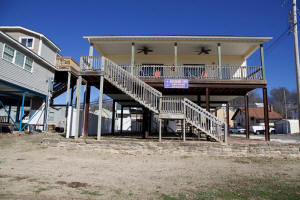For Many Illinoisans in Flood-Prone Areas, Buyouts Are the Only Way Out
 Send a link to a friend
Send a link to a friend
[May 14, 2024]
By Laura Stewart, Illinois Answers Project
April 23, 2024
 DIETERICH, Ill. – Every day, Berdeena Leturno checks her email for an
update on when the state of Illinois will finally pay her $80,000. DIETERICH, Ill. – Every day, Berdeena Leturno checks her email for an
update on when the state of Illinois will finally pay her $80,000.
It’s been over two months since she signed the paperwork to sell her
flood-damaged home as part of a buyout program, and over a year and a
half since the creek across the street rose so high that it filled her
home with water.
Now, she’s waiting to close and get the check for her old house – a
white-paneled ranch where she and her husband raised their four kids,
spent nearly 20 years and planned to retire.
The family moved out in January of last year and have been struggling to
afford two mortgages since, she said. They paid a little over $155,000
for their new property, using the money her husband had saved for when
he retired as a mechanic.
“We are drowning in debt because of this flood,” said Leturno, 58, a
retired nurse who now works as an elementary school teacher.
The buyout has taken too long, she said, but it was their only option.
“I was desperate. I wanted to get out of there.”
For many Illinois residents who live in flood-prone areas, government
buyouts provide an option when there is no other way out. Buyouts are
intended to mitigate future flood risk by removing buildings that
repeatedly flood and turning the land into open space.
In Illinois, there are two buyout programs: one run by the Illinois
Department of Natural Resources and funded through state legislative
allocation, and another run by the Illinois Emergency Management Agency
and funded by the Federal Emergency Management Agency.
Buyouts offer people in distress significant help, but they often come
with long wait times and bureaucratic complications. And they often
don’t prevent people from moving into other flood-prone areas, experts
who evaluate these programs told the Illinois Answers Project.
Buyouts also don’t relieve residents of the social, emotional and
economic toll of losing a home to a flood, local government leaders say.
Some residents don’t want to leave their community. Others want to leave
but can’t afford to, even with the state’s help. And those left behind
are forced to live among vacant lots and with the fear of future
flooding.

Despite its limitations, the state’s buyout program has prevented future
damage and made people safer, said Ron Davis, who runs the program at
the Department of Natural Resources. Buyouts also save significant
amounts of money. The National Institute of Building Sciences estimates
that federal flood buyouts save $7 for every $1 spent.
If buyouts didn’t exist, “a lot of times these people would have
nothing,” Davis said. For homeowners who can’t sell their property on
the private market, their options are limited: stay in a damaged house
and risk future flooding, or abandon the property and forfeit any future
equity from a sale.
“I would never try to claim that we’ve solved the problem in Illinois,”
he said, “but we have made a big difference in it.”
How Buyouts Became a Solution
In 1937, the Ohio River flooded Shawneetown, a shipping community on the
southeastern border of Illinois. After it was flooded with nearly 25
feet of water, the federal government moved the community in one of the
first relocations of an entire town.
The government continued one-off relocations until buyouts became more
of a “regular program” for both IDNR and IEMA in the 1980s, said French
Wetmore, who ran IDNR’s program at the time and now owns a floodplain
management consulting firm. The program picked up after a flood in 1981,
Wetmore said, and the agency relocated three communities: Peoria, Thebes
and Kampsville.
After the Great Flood of 1993, which inundated 75 towns and killed 50
people in the Midwest, local leaders and the federal government
relocated Valmeyer, a town in southwestern Illinois on the Mississippi
River. After the town’s levees failed, floodwaters damaged 90% of the
town’s structures, and local leaders decided to move 24 homes and the
town’s business district to higher ground about 2 miles east. It’s one
of the most well-known examples of community relocation, Wetmore said.
Since 1981, IDNR has bought out roughly 900 properties, Davis said. The
agency received $10 million for buyouts in the most recent state budget,
which it’s allocating to projects in eight communities: Dieterich, DePue,
Downers Grove, East St. Louis, Ottawa, Freeport, Roanoke and Romeoville.
IEMA’s buyout program picked up in 1993, and the agency has purchased
3,295 properties since then, according to the agency’s spokesperson.
How Buyouts Work
Davis said he sometimes visits communities after flood events to let
them know about the buyout program, but communities also seek his help.
The process requires local government involvement. Homeowners can’t
apply directly to the state – the local government has to submit an
application to IDNR, he said, because the ownership of the land is
transferred to the local government.
After the local government submits an application to IDNR, Davis
conducts a review to make sure the purchase is cost effective and
demolition would be safe for the surrounding habitat. The community’s
chief elected official must approve the agreement.
The local government then has the property appraised. If the owner
believes the suggested value is too low, they can hire an appraiser, and
IDNR will take that appraisal into consideration.
IDNR conducts the final review and also considers what other assistance
the homeowner has received, such as flood insurance or FEMA assistance,
before making the final offer.
Once the owner accepts the offer, the attorney general must sign off on
the buyout before IDNR schedules a closing and a demolition is booked.
Local governments pay for the buyouts and then are reimbursed 100% by
IDNR, Davis added. FEMA grants require the local government to pay for
25% of the buyouts.
While the state-funded program has fewer resources, it avoids some of
the bureaucratic slowdowns that come with federal funding. An IDNR
buyout can take about a year, Davis said, although it can take more than
five years for larger projects if the community doesn’t have the initial
funds to buy properties. FEMA-funded buyouts have an average wait time
of more than five years, according to a report by the National Resources
Defense Council.
Some city officials say IDNR’s application process is more
straightforward than many federal programs.
“It was one of the easiest grant applications I’ve ever done,” said
Brittny Gipson, economic development coordinator for the Village of
Dieterich, where IDNR is working to buy out nine homes and an apartment
building for $1.4 million. With federal grants, there are “more hoops to
jump through,” she said.
She noted that it’s been a long process because other areas flooded in
2022 and IDNR had to wait until the following year to get more funding.
But IDNR had experienced, responsive staff members to answer questions
along the way, Gipson added. “It felt like they actually, truly wanted
to help,” she said. “I’ve never had grant staff email and call me back
the same day, and they always did.”
In Watseka, a city of roughly 4,600 people that sits at the convergence
of the Iroquois River and Sugar Creek, local government leaders have
been working with IDNR to buy out about 120 homes since 2018. That year
in February, hundreds of homes were damaged in the fourth large-scale
flood to hit the city in the last 10 years, according to FEMA.
The city’s mayor, John Allhands, met with Davis at IDNR to work out a
buyout project, and the following year, IDNR allocated over $5 million
to purchase and tear down the structures and make the land open space.

[to top of second column]
|

After the Great Flood of 1993, many on Grafton’s riverfront took
federal buyouts, which helped mitigate future damage, said Ron
Davis, who runs Illinois' state buyout program. Many buildings that
remain are now built on stilts.

As of March, IDNR has closed on 74 homes, Allhands said. There are no
plans yet for what the open space will become, he added, although there
have been talks of using it for recreation like disc golf.
Allhands said one concern he has with the buyout project is population
loss, which means less tax dollars to pay for services like the police
and fire department.
But while he would love to retain residents, he said, “I don’t want to
see them stay here and suffer every time.”
“I sat in on some of the initial closings, and you could see a burden
being taken off these folks’ shoulders,” he added . “...But then you see
the traditions, the memories, and all that, and it's kind of melancholy,
bittersweet.”
Buyouts Can ‘Exacerbate Inequities’
In July 2022, major rainfall inundated East St. Louis, a low-lying city
of about 18,000 in the floodplain of the Mississippi River. In one
six-hour period, roughly 7 ½ inches of rain fell, according to the
National Weather Service.
The ensuing flood resulted in “heart-wrenching” damage, said East St.
Louis City Manager Robert Betts, who was part of the rescue effort.
Residents had to be rescued in row boats and he found some people
standing on top of their dressers.
“It was anybody's worst nightmare,” Betts said, “having to lose
everything you own in the world.”
Emergency management agencies came together to respond, and Betts
connected with IDNR to work out a buyout project. The agency allocated
$2.25 million in its fiscal year 2024 budget to buy out 39 homes and
fund other flood mitigation projects in the county, according to data
from Davis.
The buyout application should be approved in the next few weeks, Davis
said, and the project will begin then. Davis said there’s interest in
using the future open space for water detention or wetlands.
But Betts said residents are frustrated that it’s taken nearly two years
to get answers about what’s next for their homes, and some don’t want to
leave the homes they have worked for years to pay off.
For many people in East St. Louis, their home is all they have, Betts
said. Over 30% of the population lives below the poverty line, and the
median household income is just above $28,000.
The situation reflects another complication with buyouts: For many
low-income residents, moving – even with the government’s help – is not
feasible.
Because buyouts are based on home values, they “exacerbate inequities in
social vulnerability and wealth,” said Dan Abramson, associate professor
of urban design and planning at the University of Washington.
People with lower valued homes often can only afford to move to other
vulnerable locations, Abramson said. “It’s not necessarily solving the
vulnerability problem with respect to the hazard, and it creates greater
instability for and precarity for people who don’t have high-value
homes.”
Abramson added the buyout program isn't structured to help residents
carefully select a new home, so they may end up back in a flood-prone
area, which is a “huge blind spot.”
Betts said most East St. Louis residents who take the buyout will likely
move to surrounding communities like Cahokia Heights, Fairview Heights,
Belleville and Collinsville, many of which still are at risk of
flooding. His goal is to try to retain the residents in East St. Louis,
and the city is looking to identify ways to build more affordable
housing.
He added that communities of color tend to be in higher flood risk areas
due to a history of discriminatory housing policies.
An analysis by real estate company Redfin found that formerly redlined
neighborhoods face higher flood risk. Redlining was a 1930s-era
discriminatory practice that deemed neighborhoods where Black residents
lived risky for mortgage lending. Neighborhoods where Black residents
lived were likely to be coded red or yellow, while neighborhoods where
white residents lived were likely to be coded blue or green. The
practice made it impossible for Black residents to qualify for
mortgages.
In Chicago, 12.6% of homes in red- and yellow-lined areas face high
flood risk today compared with 7.9% of homes in green and blue-lined
neighborhoods, Redfin found.
Buyouts are “tied to the systematic issues we have in this country of
dealing with poor people and people of color in these harmful areas,”
said Jonathan Remo, an associate professor of geography and
environmental resources at Southern Illinois University. “It’s not
really the programs, it’s the bigger picture of how the economic system
works.”
How Buyouts Can Be Improved
Three climate policy experts told the Illinois Answers Project that
buyouts can be improved in a few ways: better land development
decisions, more funding and staffing, and a holistic approach to the
process of moving communities.
With increased rainfall and flooding, buyouts will remain inevitable,
but better development decisions should be made to prevent future
buyouts from happening, said Anna Weber, a policy analyst at the Natural
Resources Defense Council in Washington, D.C.
“We always say that the best buyout, the most successful one, is one
that never has to happen,” she said.

When a buyout does have to happen, steady funding sources and more staff
can help make the process smoother, said A.R. Siders, an assistant
professor at the University of Delaware who studies climate change
adaptation.
“One of the biggest things states can do is have a consistent pot of
money, a consistent source of funding, that is available for buyouts
year after year after year,” Siders said.
For Illinois’ state-funded buyout program, Davis is the only person on
staff in the Flood Hazard Mitigation Program. The Realty and Environment
Planning Office handles closing paperwork and other tasks related to
property sales, he said.
Some experts say buyouts shouldn’t be the answer in the first place.
Shirley Laska, professor emerita at the University of New Orleans and
co-founder of the Lowlander Center, a nonprofit that helps communities
in Louisiana adapt to climate change, said that relocation can have a
damaging effect on culture and community. About half the groups the
Lowlander Center works with are Indigenous, she said. Her organization
aims to help communities stay in place and build up more resilience to
flooding, so they can preserve their culture.
Government agencies need to take into account the important social role
that communities play, Laska said.
“If you dismiss the culture, the connection, the support systems … you
do harm,” she said. “... Just physically moving their bodies so they’re
not hit by flooding just isn’t enough.”
Leturno, whose closing is finally scheduled, said she feels the
emotional weight of relocating. She misses her neighbors and her old
house, even though they’re just down the street.
“I do have a lot of memories at the other house that we can't take with
us,” she said. “They'll just live in our hearts.”
But the health of her family is what’s most important to her, she said.
Even though the buyout has taken too long, Leturno said she’s grateful
the state could help.
“Life goes on. You’ve got to take what you can get done and move on.”
Editing for this story was made possible by a grant
from The Richard H. Driehaus Foundation to the Illinois Answers
Project.
This article first appeared on Illinois
Answers Project and is republished here under a Creative
Commons license. |